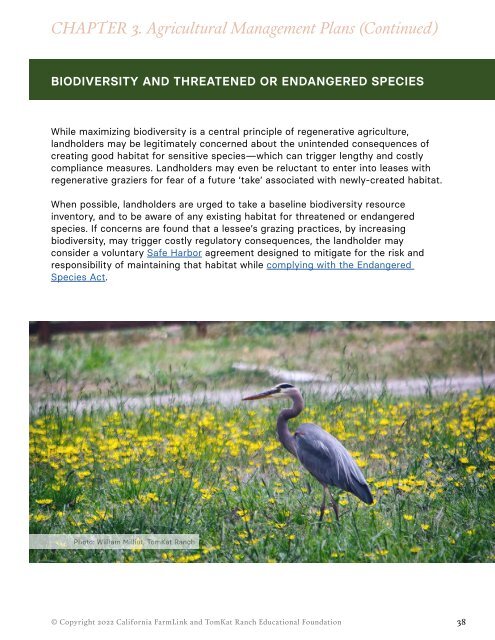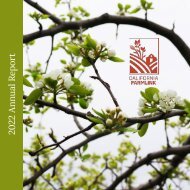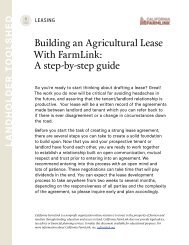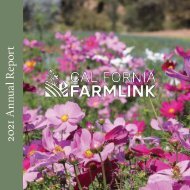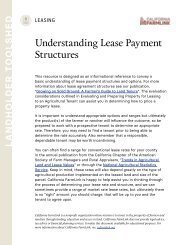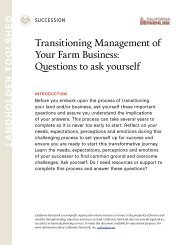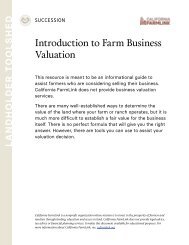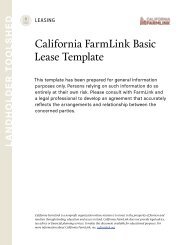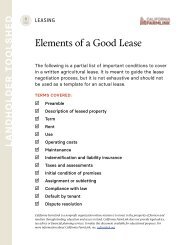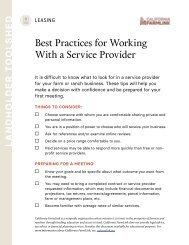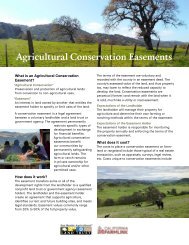Guide to Regenerative Grazing Leases: Opportunities for Resilience
California FarmLink and TomKat Ranch Educational Foundation teamed up to create this resource focused on land leases that support regenerative grazing practices. This guidebook aims to empower private, nonprofit, and public landholders, as well as easement-holders and grazing tenants.
California FarmLink and TomKat Ranch Educational Foundation teamed up to create this resource focused on land leases that support regenerative grazing practices. This guidebook aims to empower private, nonprofit, and public landholders, as well as easement-holders and grazing tenants.
You also want an ePaper? Increase the reach of your titles
YUMPU automatically turns print PDFs into web optimized ePapers that Google loves.
CHAPTER 3. Agricultural Management Plans (Continued)<br />
The second example SMART goal is <strong>to</strong> increase soil<br />
organic carbon from 0-10 cm by an average 0.5%, by a<br />
specific date.<br />
Again, careful: the achievability of this goal may depend on<br />
external fac<strong>to</strong>rs outside of the lessee’s control. To achieve a soil<br />
carbon increase, begin with a resource inven<strong>to</strong>ry of current carbon management.<br />
Identify any current on-farm practices that release carbon, and establish practices <strong>to</strong><br />
eliminate or minimize these. Focus on the water cycle by increasing infiltration; and the<br />
energy cycle: lengthen the growing season by encouraging perennial plants. Graze in a<br />
manner that supports the res<strong>to</strong>ration and health of riparian areas, and if appropriate,<br />
that recruits and establishes desired tree species. (Management of existing trees<br />
may be paramount, as under-managed savanna and <strong>for</strong>estlands can quickly become<br />
overpopulated, having an adverse carbon impact in the long run).<br />
The third example SMART goal is <strong>to</strong> ensure that ranchwide<br />
water infiltration rates exceed regional targets by<br />
a specific date.<br />
Take baseline soil tests <strong>to</strong> understand water infiltration, microbial<br />
life status, and mineral makeup of soils from the outset. Some<br />
actionable water infiltration strategies may include minimizing road area; improving<br />
road conditions and grading <strong>to</strong> slow and spread runoff; and minimizing soil compaction<br />
from repeated use of heavy machinery or poorly timed hoof traffic from lives<strong>to</strong>ck.<br />
Leaving behind plant residues and other practices can help maintain cover on the soil<br />
surface year-round, and has been shown <strong>to</strong> increase water infiltration as well.<br />
The fourth example SMART goal is <strong>to</strong> decrease the<br />
number of detected invasive plant species at a given<br />
moni<strong>to</strong>ring point by a specific date.<br />
TomKat Ranch manager, Mark Biaggi, cautions us <strong>to</strong> understand<br />
recent land management his<strong>to</strong>ry, and <strong>to</strong> test the soil <strong>for</strong><br />
imbalances that invasive plants may indicate, be<strong>for</strong>e treating the symp<strong>to</strong>m. If<br />
decreasing the prevalence of certain identified species is shown <strong>to</strong> line up with the<br />
lease’s guiding principles, the lessee may use high-density lives<strong>to</strong>ck grazing <strong>to</strong> knock<br />
them back when they are palatable <strong>to</strong> lives<strong>to</strong>ck or highly sensitive <strong>to</strong> impact. Another<br />
approach may be <strong>to</strong> instead focus on grazing strategies that promote and encourage<br />
plant species that can out compete the invasive species.<br />
© Copyright 2022 Cali<strong>for</strong>nia FarmLink and TomKat Ranch Educational Foundation<br />
37


